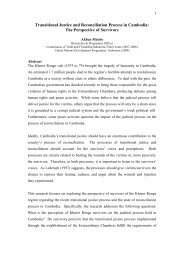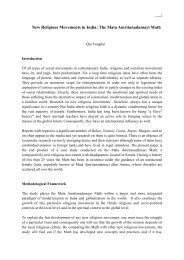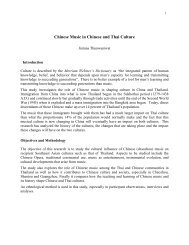Private Sector Participation in Affirmative Action in Malaysia: - Asian ...
Private Sector Participation in Affirmative Action in Malaysia: - Asian ...
Private Sector Participation in Affirmative Action in Malaysia: - Asian ...
You also want an ePaper? Increase the reach of your titles
YUMPU automatically turns print PDFs into web optimized ePapers that Google loves.
f<strong>in</strong>ancial sector to rema<strong>in</strong> <strong>in</strong> control of key f<strong>in</strong>ancial assets (Crouch, 1996).<br />
In addition, the state <strong>in</strong> <strong>Malaysia</strong> provided critical enabl<strong>in</strong>g provisions to help the<br />
Malays to establish their own enterprises and become successful bus<strong>in</strong>essmen. For<br />
<strong>in</strong>stance, special tra<strong>in</strong><strong>in</strong>g courses were started, easy loans with little or no collateral<br />
damage was provided, quotas of various k<strong>in</strong>ds were imposed and subsidized bus<strong>in</strong>ess<br />
premises were made available. Through ownership and regulation of the f<strong>in</strong>ancial sector,<br />
the government <strong>in</strong>sured the expansion of credit to the Malays bus<strong>in</strong>essmen 9 . Further, the<br />
Malay enterprises were extended special preference <strong>in</strong> the allocation of construction and<br />
other contracts, bus<strong>in</strong>ess and other licenses, and distribution agencies. Foreign <strong>in</strong>vestors<br />
were, <strong>in</strong> effect, forced to accept the Bumiputera firms as local partners (Crouch, 1994).<br />
As a result of such concerted efforts, by 1990 almost half of the Malay population had<br />
acquired shares through ASN, although most <strong>in</strong>vestments were very small. In 1990, the<br />
Malay sharehold<strong>in</strong>g had grown impressively to 20.3 per cent. Besides, <strong>in</strong> contrast to the<br />
situation <strong>in</strong> 1980, most (14 per cent) of the shares were held by <strong>in</strong>dividual Malays than by<br />
government agencies (MTR-4).<br />
Employment Restructur<strong>in</strong>g<br />
To rectify severe Malay underrepresentation <strong>in</strong> the corporate sector, the government<br />
preferred to <strong>in</strong>tervene <strong>in</strong> labour markets. The prime targets of <strong>in</strong>tervention were the<br />
rapidly grow<strong>in</strong>g manufactur<strong>in</strong>g and service sectors. The government made issuance of<br />
manufactur<strong>in</strong>g licenses conditional on the applicant firm’s compliance with the<br />
Bumiputera employment quota. Apart from mak<strong>in</strong>g trade licenses conditional to<br />
fulfillment of Bumiputera quota, the government made Bumiputera employment a<br />
condition <strong>in</strong> provid<strong>in</strong>g any approval for projects that sought capacity expansion. The<br />
9 Under NEP, the banks were directed to <strong>in</strong>crease their lend<strong>in</strong>g to Bumiputras. While <strong>in</strong> August of 1974,<br />
banks were required to provide at least 12 per cent of their loans to Malays, this was enhanced to 20 per<br />
cent <strong>in</strong> October, 1976. Consequence of this decision, bank credit to Bumiputera rose from RM 149 million<br />
<strong>in</strong> 1971 to RM4, 780 million (20.6 per cent) <strong>in</strong> 1980. Commercial banks which were lend<strong>in</strong>g to the tune of<br />
3 per cent of their total loans to small enterprises, were asked to raise it to 10 per cent by 1975. In fact, the<br />
government set up the Credit Guarantee Corporation (CGC) which took the job of underwrit<strong>in</strong>g guarantees<br />
for 60 per cent of loans given by commercial banks to small bus<strong>in</strong>essmen (see Lim Mah Hui 1985). In<br />
1977, the CGC had guaranteed 54, 591 loans worth RM480.4 million, with 67 per cent of the total loans,<br />
account<strong>in</strong>g for 42 per cent of the total value, go<strong>in</strong>g to Bumiputera (see Chee, et al, 1979).<br />
14







